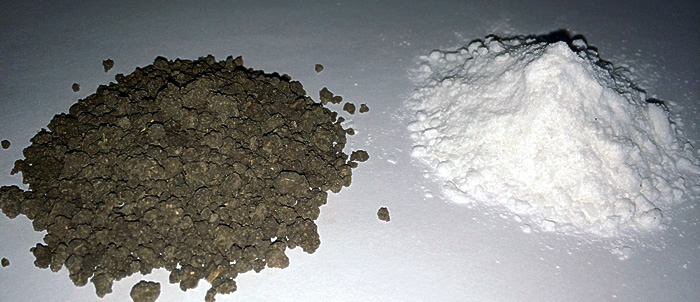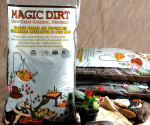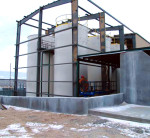Nutrient management, demand for organic fertilizers and the need for non-energy revenue streams are driving development of high-value coproducts using digestate.
Peter Gorrie
BioCycle August 2014
Most discussion of anaerobic digestion focuses on energy production — either electricity or renewable natural gas. But economics, water scarcity and environmental concerns are combining to shift operators’ gaze to the digestate, material left after the biogas has been extracted from organic wastes.
Digestate is full of nutrients, including nitrogen, phosphorous, potassium and sulfur. If the digested material contains manure or cellulosic wastes, the residue is also loaded with tough absorbent fibers. The aim is to extract these ingredients and process them into “coproducts” that will generate revenue, making it more likely additional digesters will be built and enhancing the technology’s already substantial environmental benefits.
Because various companies are trying to develop their own patented processes to make coproducts, “it’s one of the most sensitive topics” in anaerobic digestion, says Patrick Serfass, Executive Director of the American Biogas Council (ABC) in Washington, D.C., which has a Coproducts Working Group to encourage development of these new materials. “It’s the sweet spot … cutting edge,” adds Serfass.
Digestate is already employed in lower value products. The solid portion is often removed and dried for use as animal bedding. The liquid is spread on farm fields as a free or low cost fertilizer and soil conditioner. Because digestion kills many pathogens and odors, it’s a relatively benign product. But these uses have limits: They generate minimal income and the quantity of liquid digestate often exceeds the capacity of nearby land to absorb its nutrients.
Thus, the search for ways to convert the ingredients into coproducts. The focus remains on products that will enhance soil, from farms to golf courses and the burgeoning business of home gardening. The nutrients — the most important are nitrogen, phosphorous, potassium and sulfur — are separated and concentrated for sale in liquid, pellet or dry format, to create enhanced organic fertilizers. The fibers go mainly into products that improve soils’ ability to control moisture and nutrient release. Other potential options include making plant boxes, land stabilization materials, pressboard for home construction or additives to increase the strength of plastics.
Developing higher-value uses of digestate has been less of a need in other countries, such as in Germany, where high energy prices and government incentives ensure operators receive enough income from energy production to make digesters profitable. Most digestate there is simply stored until it can be applied to nearby farm fields.
But that’s not the case in most of North America, where electricity and natural gas prices are low and many operators need additional income streams for their facilities to be financially viable. “Innovation is happening here because energy prices are low,” Serfass says. “Energy sales alone don’t make projects pencil out.”
In most American states and Canadian provinces, “anaerobic digesters don’t receive the same level of incentives as other renewable energy technologies,” notes Amy McCrae Kessler, cofounder of Turning Earth, LLC, an organics recycling company that is developing a facility in Connecticut to produce biogas as well as compost for a variety of soil products. “We need to generate revenue from every input and every output, including tipping fees, energy production and coproducts.”
McCrae Kessler, a member of the Board of ABC and cochair of the Council’s AD Coproduct Working Group, explains that ABC created this group “because we found that key stakeholders within the industry as well as policy makers, regulators and the general public, were not aware that in addition to renewable energy, digesters produce a very valuable product that’s full of important nutrients. Most see it as a cost center or waste stream, but it really should be viewed as another feedstock for making high value products. To grow the industry we need to focus on growing the coproducts sector.”
Market Drivers
Factors driving the need to develop high value markets include new regulations governing landfilling and water quality. Massachusetts, Vermont, Connecticut and Rhode Island have approved landfill disposal bans on food and some other organic wastes, and other states, most notably New York and California, are expected to follow. Such moves generate a large potential supply of high energy digester feedstock — and thus more digestate.
As well, the U.S Environmental Protection Agency is clamping down on excess nutrients flowing from farm fields into American waterways, notes Jerry Bingold, the Innovation Center for U.S. Dairy’s director of renewable energy. “That makes manure management an increasingly essential but expensive and difficult task,” Bingold says. “Development of coproducts changes an expense into a profit center.”
Land application remains feasible when digesters are located near large areas of farmland but it “can’t be the only solution,” comments Clemens Halene, chief operating officer at quasar energy group, which is developing coproducts at its operation in Wooster, Ohio. “If you’re totally dependent on land application you have a problem.” Quasar has first-hand experience with that issue as it’s facing strong opposition to land application of liquid digestate from another of its digesters in western New York State.
“Water scarcity is another important driver,” notes Bob Joblin, president of Arkansas-based Cenergy USA, which produces a peat moss substitute called Magic Dirt from digested dairy manure (see “Digested Dairy Manure To High-End Potting Soil,” July 2014). Removing nutrients and fibers from digestate leaves behind relatively clean water that can be recycled for many uses short of human consumption. “The more the digested effluent is cleaned, the more it can be used for other purposes,” he adds.
In one example of how all these benefits are seen to combine, the U.S. dairy industry is promoting coproducts, mainly recovery of nitrogen and phosphorous, as a crucial means to ensure the financial success of installing anaerobic digesters to manage the wastes from millions of cattle and ensure the industry meets its goal of reducing greenhouse gas emissions by 25 percent by 2020. About 200 U.S. farms have installed digesters and that number is growing by roughly 15 per year, according to “National Market Value of Anaerobic Digester Products,” a 2013 study compiled by consultants Informa Economics for the Innovation Center for U.S. Dairy.
Many farm digesters already improve their finances through codigestion, which involves boosting biogas production by spiking the manure feedstock with higher energy wastes from food processing and source separated organics programs. But that’s not enough, the Innovation Center report states: “Energy production alone produces insufficient economic returns to justify a major national investment in digesters.”
The solution? Continues the report: “A new business model (with) the potential to transform the … industry …. [that] incorporates advanced technology to treat both dairy manure and off-farm food wastes using a core anaerobic digestion technology, with associated nutrient recovery … within a positive business model.” Income from coproducts could generate about $1.3 billion annually, or 45 percent of the total potential income if all 2,647 American dairy farms housing more than 500 head of cattle installed digesters, according to the report. Energy production, even including renewable energy credits from governments, would bring in just $930 million, it states.
The ABC’s Coproducts Working Group looks at “what people are doing with digestate today and what can they do with it going forward to create value for their projects,” notes McCrae Kessler. “We want to encourage stakeholders within and without the industry to look at possibilities.”
Standards Development
ABC also aims to create a classification system for permissible end uses of coproducts based on their stability, feedstock origin and absence of contaminants. It is holding a preconference workshop at BioCycle East Coast Conference 2014 on October 27 to kick-start the process (www.BioCycleEastCoast.com).
Great Britain’s WRAP (Waste Reduction Action Programme) — a government-funded nonprofit created in 2000 to promote all forms of waste reduction — is leading the development of a set of standards, based on feedstock quality and the intended end uses of digestate for that country. “We hope the ABC will develop a standard for fully digested material that would … ensure a stable feedstock for producing a number of coproducts,” McCrae Kessler says.
The added cost to make coproducts isn’t that high, notes Trevor Nickel, general manager of Edmonton, Alberta-based Himark Biogas. “It’s all relatively well-known equipment. If you were going to take digestate further — dry and pelletize it — the capital cost would not be more than 10 percent higher” than the capital cost of the original digester. “It’s really a matter of, ‘does the plant owner want to take the risk?’, he adds. While most are focused on selling energy, more and more want zero discharge or clean water discharge, which means they’ll create higher quality digestate products. But that requires getting involved in marketing. I tell them once they go that direction they need to employ a salesperson.”
But market resistance remains. North Americans, unlike most Europeans, are still tied to fossil-fuel-based chemical products. It will take a tipping point similar to what happened when organic foods went mainstream, Nickel says. “If digestate products were available in significant volumes on a regular basis, and given the fact they’re so much better, people will use them more, and transfer from chemical products. For now, there’s not enough digestate to even test the market.”
Financing, too, can be a hurdle, since the potential income from coproducts — even though it’s considered vital for many projects — may be uncertain in advance of production, says Doug VanOrnum, head of business development and research at DVO Inc., in Chilton, Wisconsin: “If you can’t guarantee revenue you can’t get anybody to invest. Project pro-formas typically need to be based on energy production, and others (coproducts) tend to be added later.”
Still, industry participants say, coproducts are the way of the near future. North America’s mountain of all types of organic leftovers “can no longer be considered waste,” Joblin says. “It has to be an asset. We have to find revenue-generating uses for it.”
Peter Gorrie is a Contributing Editor to BioCycle.





















